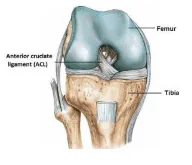The ACL: What is it, what does it do and why does it matter?
As you watch the NCAA March Madness basketball games, a player makes an athletic cut towards the basket, when suddenly he feels a “pop” and falls to the ground, clutching his knee. The crowd goes silent as the coach and Athletic Trainer rush out to the court and check on the player. What has happened is a common occurrence during athletic contests and recreational sports across the United States. The basketball player has just sustained an anterior cruciate ligament or ACL tear, which is just the beginning of a long road to recovery.
Unfortunately, this type of knee injury is extremely common among active people, in fact it’s estimated that 200,000 injuries are reported annually. The prevalence of injuries to the ACL is alarming because of the major role it plays in the stability and function of the knee and the long term effects it can have on a person’s knee following an injury. The good news is that research has shown that ACL injury risk can be greatly reduced by identifying modifiable factors in those most at risk for injury. The aim of this post is to educate on what the ACL is, what it’s function is, how it is injured, can it be prevented and what role physical therapists can have in both prevention and recovery after injury.
What is the ACL or Anterior Cruciate Ligament of the knee?
- The ACL band of thick connective tissue which starts on the femur (thigh bone) and connects to the tibia (shin bone). It’s primary function is as a stabilizing structure that resists the anterior (forward) translation of the tibia as well as rotational loads placed on the lower leg.
- It is one of four ligaments which provides a large amount of the stabilization to the knee during activities like walking, running, jumping, stair climbing as well as other everyday activities.
How is the ACL injured or torn?
- Approximately 70% of ACL tears are from non-contact injuries which occur when a person either plants their foot and changes direction quickly, suddenly stops, jumps and lands on an extended knee and/or twisting their knee putting stress on the ACL.
- The ACL also can be torn by a direct blow to the knee which stretches the structures in the knee resulting in a potential tear of the ACL as well as damage to other structures.
Can an ACL injury be prevented?
- ACL injury cannot be 100% prevented, however there are ways to decrease risk considerably by addressing limitations or deficits in:
- Hip Strength
- Motor control
- Balance/Proprioception
- Jumping/Landing mechanics
- Core Stability/Strength
- Reaction time
Who is at risk?
- Identifying those at risk can help reduce injury probability or reoccurrence.
- Those at risk include:
- People with deficits in one or more of the modifiable risk factors listed above.
- Females: research has shown females can be 1.5 to 4 times more likely to tear their ACL when compared to males. Anatomical, strength/muscular control and hormonal factors have been identified as putting females at greater risk.
- History of ACL tear: there is a high recurrence rate of ACL tears at about 30% of people re-injuring their ACL when returning to sport or activities with residual strength or control deficits.
What role can a physical therapist play in the prevention and rehabilitation of ACL injuries?
- Physical Therapists (PT’s) can help identify potential risk factors or underlying deficits which can increase risk for ACL or other injury by using screening tools or by performing thorough movement evaluations.
- PT’s can then use the information gathered through evaluations to develop specific training programs or interventions to address those functional limitations or weaknesses to prevent injury.
- If an ACL injury has already been sustained, the PT can develop a safe and progressive plan of care to ensure the person can safely return to sport or activities.
Please leave comments and questions below. We will have a follow-up post to let you know about our upcoming Workshop on ACL Injury Risk Screening.
-Dan
Image citations:
- http://fitletes.com/nation/wp-content/uploads/2016/02/NON-CONTACT-ACL.gif
References:
- Darin A. Padua, Lindsay J. DiStefano, Timothy E. Hewett, William E. Garrett, Stephen W. Marshall, Grace M. Golden, Sandra J. Shultz, and Susan M. Sigward (2018) National Athletic Trainers’ Association Position Statement: Prevention of Anterior Cruciate Ligament Injury. Journal of Athletic Training: January 2018, Vol. 53, No. 1, pp. 5-19.
- Ardern CL, Ekås GR, Grindem H, et al 2018 International Olympic Committee consensus statement on prevention, diagnosis and management of paediatric anterior cruciate ligament (ACL) injuries Br J Sports Med Published Online First: 24 February 2018. doi:10.1136/bjsports-2018-099060
- Hewett, T. E., Myer, G. D., et al. Mechanisms, prediction, and prevention of ACL injuries: Cut risk with three sharpened and validated tools. Journal of Orthopaedic Research, 2016 34(11), 1843-1855. doi:10.1002/jor.23414



